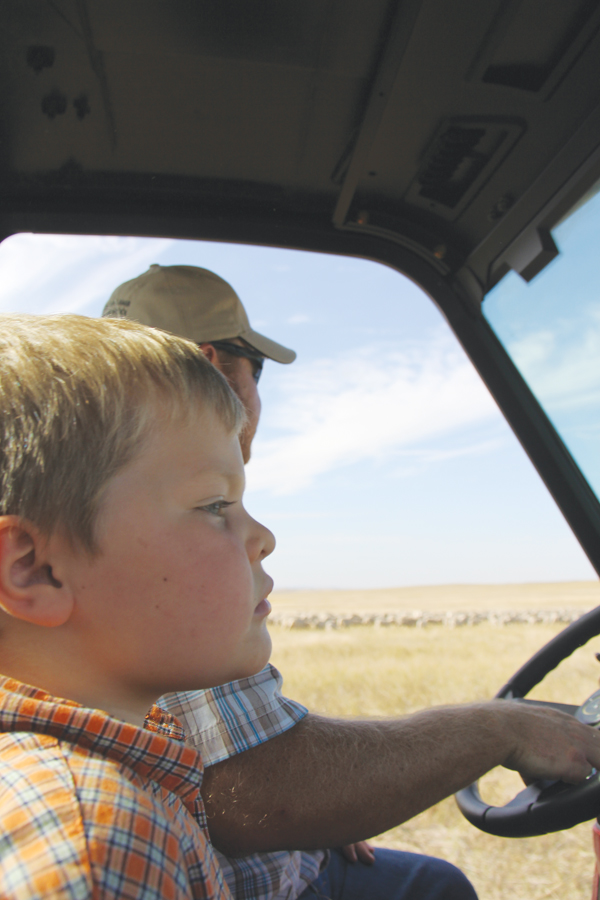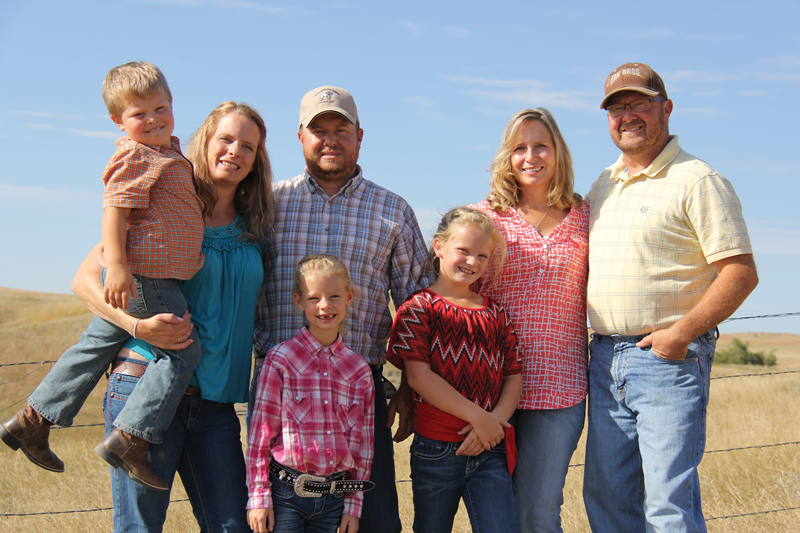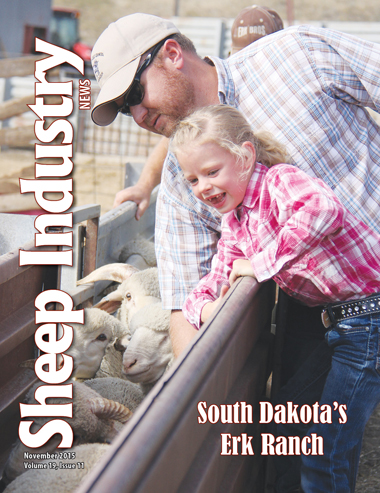Fifth-Generation South Dakota Ranchers Concentrate on Wool
KYLE PARTAIN
Sheep Industry News Editor
Attending the 2014 ASI Convention in Reno, Nev., last January, Anna Erk’s world came full circle.
 She had escaped the hotel meeting rooms for a few hours and wandered into Jimmy Beans Wool just a few minutes down the road. Still wearing her convention name tag, clerks in the store recognized her last name. While it took a minute or two for them to realize how they knew the name, they soon disappeared into the store’s isles of yarn and returned with selections from Swans Island’s All-American Collection.
She had escaped the hotel meeting rooms for a few hours and wandered into Jimmy Beans Wool just a few minutes down the road. Still wearing her convention name tag, clerks in the store recognized her last name. While it took a minute or two for them to realize how they knew the name, they soon disappeared into the store’s isles of yarn and returned with selections from Swans Island’s All-American Collection.
The yarn – constructed from 75 percent Rambouillet wool and 25 percent alpaca fiber – got its start on the Erk’s fifth-generation ranch in northwestern South Dakota.
A glance at the back of the packaging includes the following, “Alpaca fiber from small East Coast farms is blended with Rambouillet wool from the Erk Ranch in South Dakota, where raising sheep has been a family tradition for over 100 years.”
Anna, of course, knew about the line of Swans Island yarns and the family’s role in the process, but for a “born and raised city girl” it was a cool moment that provided a great look at the end product that comes from a thousand sheep roaming the family ranch outside of Newell.
Wool has always been the family’s top priority, raising Rambouillets that average about 20 micron within their commercial herd.
Paul Erk’s grandfather immigrated from Germany in the early 1900s, saved $1,000 while working on a farm and eventually headed west to claim a homestead in Butte County, S.D., in 1912. In the 100-plus years that have passed since he first set foot on the land, the family has lost its entire sheep herd three times – twice to weather and once to the depression. While the challenges might have tested the family’s resolve, they’ve never given up on running sheep or turning out top-quality wool.
“That’s always been our main concern here,” says Paul, who plans to oversee operations on the family ranch for a few more years before turning it over to the next generation. “We were some of the first in this area to skirt and class our wool. Everybody in the family has been to a classing school. That’s just another way that you can see how important the wool is to us.”
In fact, when the family first began working with Swans Island, the company found the Erk Brothers wool to be too fine.
“They needed a little courser wool than what we have in our commercial flock,” Paul says. “Fortunately, we’d just bought a new load of sheep that were 2.5 microns courser than the rest of our sheep. So, they tried that and liked it.”
Purchased from Wyoming after the Atlas storm that devastated cattle ranchers a couple of years ago, the family still refers to the flock as the “Wyoming sheep.” They run apart from the commercial herd on land leased from the estate of Paul’s uncle, George.
“We’ve always run a few cattle and we were going to replace them after the storm when John came up with the idea to just buy more sheep instead. We could get a lot more for our money buying sheep instead of cows. The whole family (Paul and his children, John, Chad and Megan) owns those sheep together. Working with the mill has been a wonderful thing that we lucked into, but it wouldn’t have happened if we hadn’t bought those sheep.”
Larry Prager at Center of the Nation Wool handles the family’s wool, and Paul figures most of it ends up in products for the U.S. military.
“I didn’t realize it until I served on the wool council a few years ago, but it is amazing some of the products they make out of wool these days. They gave us a military T-shirt made from wool that is just as comfortable as any cotton shirt I’ve ever worn. I probably never owned a pair of wool socks until five years ago, but now I won’t wear anything else. I’ll never buy another pair of cotton socks. It’s just amazing what they are doing with wool these days.”
Among the family’s 1,000 head of sheep on the ranch are various flocks owned by each of Paul’s children. John, for instance, purchased quite a bit of his great uncle’s registered flock when George retired in the early 1990s. Megan owns part of those sheep, as well, but they run together and are exposed to the same stud rams during breeding season. Chad and his wife, Amber, handle the cattle side of the ranch, but also work with the sheep. Chad is always there to lend a hand at the ram sales, for instance.
The registered flock includes about 250 head, with the remaining 750 sheep in the commercial flock.
“We’re probably one of the biggest registered Rambouillet breeders still out there,” Paul says. “A lot of people have gotten away from the registered flocks. I wouldn’t call us different, because we’re in the business of selling rams. But we cater to the range industry. People who buy our rams do it because they have a good wool clip and they want to keep it that way. They know our rams have good wool. We’ve put a lot of years into that.”
 While much hasn’t changed around the ranch in the last 50 years, the family hasn’t been afraid to embrace different ways of doing things or the chance to add technology to the operation.
While much hasn’t changed around the ranch in the last 50 years, the family hasn’t been afraid to embrace different ways of doing things or the chance to add technology to the operation.
“We did some crossbreeding at one point because we thought we might add five to 10 pounds on our lambs, but we just didn’t,” Paul admits. “I’m really bad about thinking there’s only one breed of sheep, and that’s Rambouillet. I’m sure there are plenty of breeders that would argue with me, but we’re pretty happy with the great wool we get and the meat that they produce.”
While John and Anna both have day jobs in town – John’s an engineer and Anna is a school teacher – they have certainly helped Paul and Beth look to the future of the ranch. Through various sheep industry educational programs, John and Anna have learned a lot about technological advances that can help make the family ranch more productive in the future.
Erk Brothers is now working with the National Sheep Improvement Program to track and monitor its herd in a number of areas.
“We just got started a few years ago and we had a lot of mistakes at first,” he says. “Because of that, we went to the electronic ID tags and that’s helped cut down on mistakes. With the size of our flock, it can be very time consuming because of all the paperwork that goes with getting started. But we’re getting it under control.
“I think it will make our genetic selection a lot easier. We’ll have some numbers that we can rely on instead of just going with what might look the best to us. We might know that this is our best stud, so we don’t have to put him on our best ewes. We can make some quicker genetic changes with the information we’re getting.”
NSIP has also served to reinforce what the family has been doing for years.
“We got the results back as we were driving home from the Fine Wool Consortium in Colorado,” Paul says. “John was looking at them and I said, “I bet that one ram has a negative staple length, and it was like -3.5. So, it’s validating some things we already knew, but there’s also a lot we can learn from it.”
The original Erk Brothers – George, John and Joe – always stressed the importance of ram selection, Paul says.
“I’m sure when I took over and they saw some of the ones I bought, they wondered if I knew what the hell I was doing,” Paul says. “I’ll probably think the same thing when I turn things over to my kids in a few years. Maybe this will make it easier on all of us because we’ll have some actual information instead of just basing it all on what we can see.”
Currently, Paul does “all the work” on the ranch while the remainder of the family “manages.” But the time is coming when that will no longer be the case.
“Mom and dad were big on us going to college and getting an education before we could even think about coming back to the ranch,” John says. “I have a great job that I really enjoy, but the ranch is my passion. It’s a great way to raise kids and teach them to have a great work ethic. The kids love the ranch and I don’t want them to lose that.
“I already spend all of my vacation days out here.”
There’s no doubt working full-time on the ranch is John’s goal for the future.
“He gets so stressed out during the week, then comes out here and it all just goes away,” says Anna, who has shed her city-girl image for the role of rancher’s wife. “Ranching is in the whole family’s blood now.”


